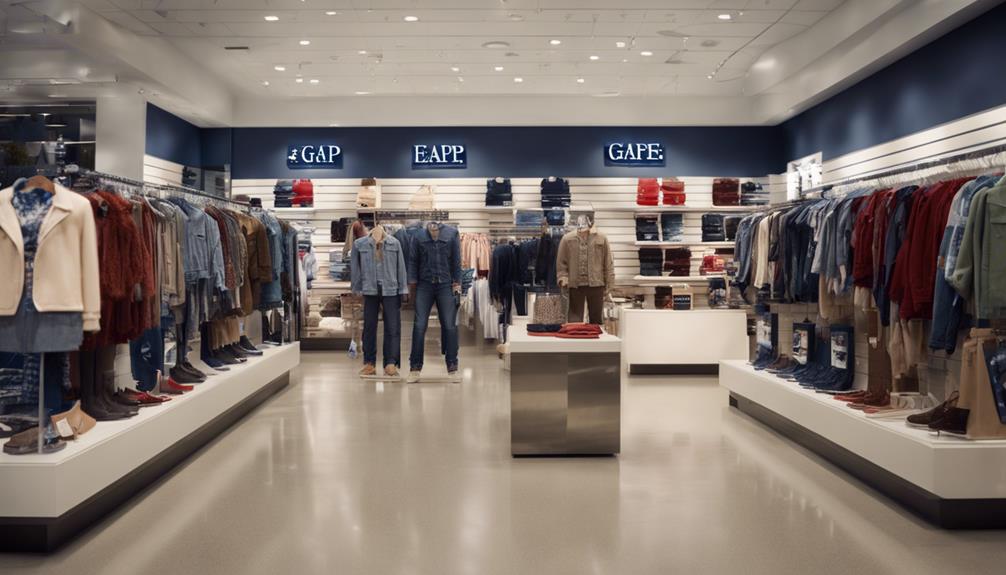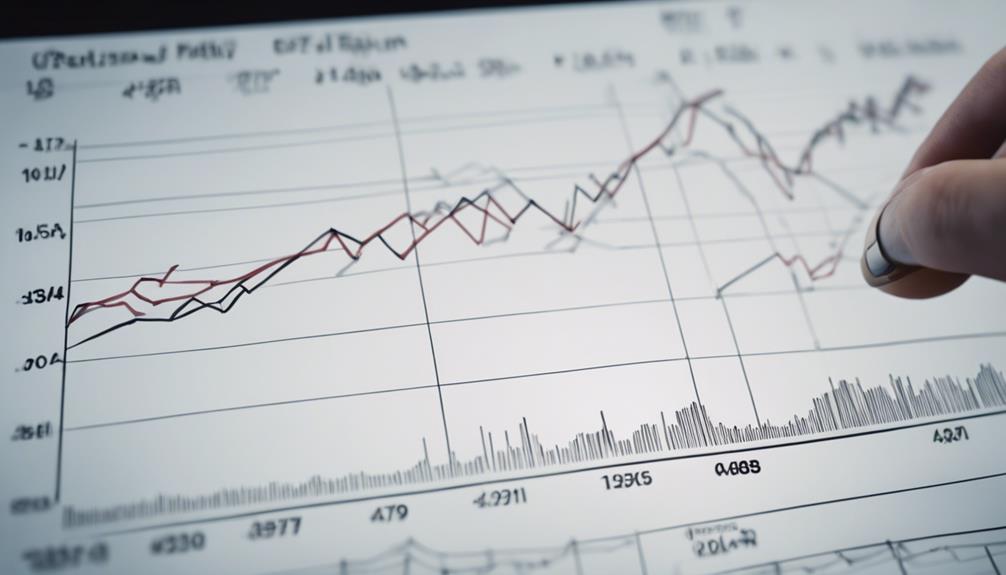Amidst compelling evidence of sustained strength in American Eagle's fundamentals and positive growth trajectory compared to Gap's challenges, the Investment Club has decided to reverse last month's downgrade. This shift in market sentiment reflects the company's promising future growth prospects and strategic focus on profitability, setting it apart in the retail landscape. Factors like the $211 million operating income target, consumer preferences favoring American Eagle, and the impact of inflation on retail sales all point towards a favorable outlook for the company. Further insights await those interested in uncovering the full scope of American Eagle's resurgence.
Key Takeaways
- Continued strength in American Eagle's fundamentals
- Stable operating income despite $16.50 stock price
- Retail sector showing signs of consumer health
- Management exploring value-creating opportunities like a spin-off
- Positive growth trajectory contrasts with Gap's challenges
Reasons for Reversing American Eagle's Downgrade
Upon reevaluation, the Investment Club decided to reverse American Eagle's downgrade due to compelling evidence of continued strength in the company's fundamentals. The information provided indicated that despite the recent stock news of American Eagle trading at $16.50, which was 9% lower than the downgrade price, there was no significant slowdown in the company's operating income.
Market sentiment, perhaps overly negative, may have influenced the initial downgrade, but upon closer examination, it became clear that the retail sector, bolstered by signs of consumer health such as low unemployment rates and wage increases, was still favorable for American Eagle. Additionally, management's contemplation of potential value-creating opportunities, like a spin-off, further supported the decision to reverse the downgrade.
This reevaluation highlights the importance of looking beyond short-term fluctuations and rumors to make informed investment decisions based on solid company fundamentals and market conditions.
Comparison With Gap's Outlook

Gap's current earnings outlook contrasts starkly with previous years, pointing to fundamental challenges the company faces.
With Gap's stock trading below $10 and partnerships impacting its market performance, a comparison with American Eagle's future growth prospects and financial performance analysis becomes imperative for investors seeking to make informed decisions.
Gap Vs. American Eagle
American Eagle's positive growth trajectory stands in stark contrast to Gap's concerning earnings outlook, indicating diverging paths in the retail industry. While American Eagle Outfitters has been experiencing growth and positive momentum, Gap is facing challenges with a markedly lower earnings outlook. This disparity is reflected in Gap's current stock price, which is below $10, signaling performance struggles. Analyst Kimberly Greenberger's projection of a 30% downside for Gap further underscores the risks and hurdles the company is up against. Additionally, Gap is perceived as fundamentally challenged, with its brand Old Navy being a key driver amidst its overall struggles. The partnerships and collaborations of both companies may also play a role in shaping their market positions.
| Aspect | American Eagle Outfitters | Gap |
|---|---|---|
| Earnings Outlook | Positive growth trajectory | Concerning outlook |
| Stock Price | Reflects positive performance | Below $10, indicating challenges |
| Analyst Projection | Positive momentum | 30% downside projected by Kimberly Greenberger |
Future Growth Prospects
Contrary to the challenges faced by Gap, the future growth prospects for American Eagle Outfitters appear promising due to its positive operating income target and consumer preference trends.
American Eagle has set an operating income target of $211 million for the fiscal year, showcasing a more optimistic outlook compared to Gap's markedly lower earnings expectations. Analyst Kimberly Greenberger's projection of a 30% downside for American Eagle contrasts with Gap's stock price remaining below $10, indicating a more favorable position for American Eagle in relation to potential growth.
Gap, being considered a fundamentally challenged company with struggles within its brand portfolio, faces negative earnings revision risk for 2023 and inventory challenges, further highlighting the disparity in growth opportunities between the two companies.
With consumer preferences leaning towards basic and high-quality clothing, American Eagle may be better positioned to capitalize on these trends compared to Gap in the current market environment.
Financial Performance Analysis
Despite facing inventory challenges and a potential negative earnings revision risk in 2023, American Eagle Outfitters maintains a focus on profitability with its set operating income target of $211 million, contrasting with Gap's struggles in achieving higher earnings and maintaining a stock price below $10.
American Eagle's inventory surge of 46% year over year presents a hurdle for the company, potentially impacting its financial performance. Analysts' predictions of a notable earnings revision risk for American Eagle in 2023 further cloud the company's outlook.
In contrast, Gap is grappling with a considerably lower earnings forecast and a stock price that remains below the $10 mark, indicating ongoing challenges in financial performance.
American Eagle's strategic emphasis on profitability through its operating income target sets it apart from Gap's current struggles, highlighting differing approaches to financial management and performance within the retail industry.
The contrasting trajectories of these two companies underscore the complexities and uncertainties present in the current retail landscape.
Potential Turnaround Factors

Exploring strategic initiatives could be key to American Eagle's potential turnaround. By taking into account various factors such as stock price, market sentiment, and recent developments, investors may gain insight into the company's future prospects. Below is a table highlighting some key elements to ponder:
| Factors | Analysis | Importance |
|---|---|---|
| Stock Price | Currently at $16.50, 9% lower post-downgrade | Indicates market perception |
| Market Sentiment | Possibly overly negative, overlooking positives | Influences investor behavior |
| Retail Sector Health | Consumer strength, low unemployment, wage growth | External support for industry |
| Company Fundamentals | CFO reports no business slowdown | Internal operational stability |
| Management Initiatives | Actively exploring value-creating opportunities | Future growth potential |
Analyzing these factors comprehensively can provide a thorough view of American Eagle's position and the potential for a turnaround. As management explores new strategies and the retail sector shows signs of resilience, the company may be well-positioned for future growth and success.
Consumer Preferences & Market Trends

Consumer preferences in the current market trend toward basic and high-quality clothing options, reflecting a shift towards durability and premium goods. This shift is evident in the rise of premium menswear brands like Roan in the market, indicating a growing demand for well-made, long-lasting apparel.
American Eagle Outfitters (AEO) stands to benefit from this trend as consumers increasingly prioritize quality and longevity in their clothing choices. The preference for durable and premium goods is particularly impactful in an inflationary environment, where shoppers seek products that offer lasting value for their money.
As consumers become more discerning in their fashion choices, AEO's focus on providing well-crafted, high-quality clothing aligns well with these evolving preferences. By understanding and adapting to these consumer trends, AEO can position itself as a go-to destination for individuals seeking both style and substance in their wardrobe.
Impact of Inflation on Retail Industry

Inflation's impact on the retail industry is significant, affecting various aspects of the sector.
As prices rise due to inflation, retailers may face challenges in managing costs and maintaining profit margins.
Consumer purchasing power can also be influenced, altering spending habits and overall sales performance.
Inflation's Effect on Sales
How does inflation impact sales within the retail industry, and what strategies can retailers employ to navigate these effects effectively?
Inflation can have a substantial impact on retail sales, particularly for companies like American Eagle Outfitters (AEO). As inflation leads to higher prices for goods and services, consumers may experience a decrease in purchasing power, affecting their willingness to spend on retail items. Additionally, rising inflation often results in increased production costs for retailers, prompting them to raise prices to maintain profitability. This, in turn, can influence consumer sentiment and spending behavior, directly impacting retail sales performance.
To navigate the effects of inflation on sales, retailers, including AEO, may need to implement effective pricing strategies. These strategies could involve carefully evaluating and adjusting pricing models to reflect changing cost structures while remaining competitive in the market. By understanding the implications of inflation on consumer behavior and sales performance, retailers can adapt their pricing strategies accordingly to mitigate the negative impacts and sustain profitability in a challenging economic environment.
Price Increases for Products
Price increases for products in the retail industry are a direct result of inflationary pressures impacting the market. This phenomenon is causing challenges for retailers like American Eagle, as they navigate the delicate balance between maintaining profit margins and keeping prices competitive for consumers.
To address these issues, companies in the retail sector are implementing various pricing strategies to offset the impact of inflation on their businesses. Some of the strategies being employed include:
- Adjusting pricing models to account for rising costs of raw materials and transportation.
- Monitoring consumer behavior closely to make informed pricing decisions.
- Exploring cost-saving measures within their operations to mitigate the effects of inflation.
- Offering promotions and discounts strategically to attract customers while safeguarding profitability.
Inflation's influence on pricing strategies is a critical consideration for companies like American Eagle as they adapt to changing market conditions and ensure long-term sustainability in the face of economic challenges.
Consumer Purchasing Power
Consumer purchasing power in the retail industry is greatly affected by inflation, influencing spending habits and consumer behavior. As inflation erodes the value of money, consumers may find their budgets stretched thinner, leading them to prioritize essential purchases over discretionary spending. This shift can prompt retailers to adjust their pricing strategies to maintain sales volume amidst rising prices.
In an inflationary environment, consumer preferences may also pivot towards high-quality, durable products as individuals seek to maximize the value of their expenditures. Understanding how inflation shapes consumer behavior is paramount for retailers looking to adapt and succeed in fluctuating economic conditions.
Forecast for American Eagle's Performance

Looking ahead, analysts project a positive trajectory for American Eagle's performance based on the significant growth in adjusted earnings per share and revenue, coupled with the substantial increases in digital and store sales. This forecast is supported by the following key factors:
- Adjusted earnings per share surged by almost 65% to 61 cents.
- Revenue for American Eagle soared by 12% to reach $1.68 billion.
- Digital revenue experienced a notable 19% increase, while store sales climbed by 10%.
- Comparable sales for American Eagle exhibited a solid 6% growth rate.
These robust numbers indicate a healthy trend for American Eagle's financial performance, with both its core brand and Aerie segment showing promising results. The company's ability to drive growth across various channels bodes well for its future outlook in the retail sector.
Frequently Asked Questions
Is American Eagle a Good Investment?
American Eagle presents a compelling case for investment. With a notable 65% surge in adjusted earnings and a 12% revenue spike, the brand is showing robust performance.
Both digital and store sales are on the rise, with a 19% increase in digital revenue and a 10% growth in store sales. Comparable sales are up by 6%, and the Aerie brand business experienced a remarkable 16% revenue boost.
These figures indicate American Eagle's promising investment potential.
Why Is American Eagle Stock Down?
American Eagle's stock is down because of a recent downgrade from buy to neutral by Janney Montgomery due to excess inventory overhang. This adjustment, impacting investor sentiment, led to a negative revision in the stock rating.
Investor worries about excess inventory affecting the company's performance contributed to the decline. The market reacted to this change, reflecting concerns about American Eagle's future prospects.
What's Happening to the US Stock Market?
The US stock market is experiencing fluctuations due to various factors, such as economic indicators, geopolitical events, and investor sentiment.
While market volatility can be influenced by global trends and domestic policies, it's important to monitor financial news, earnings reports, and economic data for insights into market movements.
Understanding market dynamics and diversifying investments can help mitigate risks and optimize returns in this ever-changing landscape.
Conclusion
To sum up, the investment club has decided to reverse the downgrade of American Eagle due to promising factors such as potential turnaround strategies and consumer preferences. Despite recent market trends and inflation concerns, American Eagle's forecasted performance looks optimistic.
When it comes to investing, sometimes it's worth taking a second look at a company's future potential before making a final decision.










